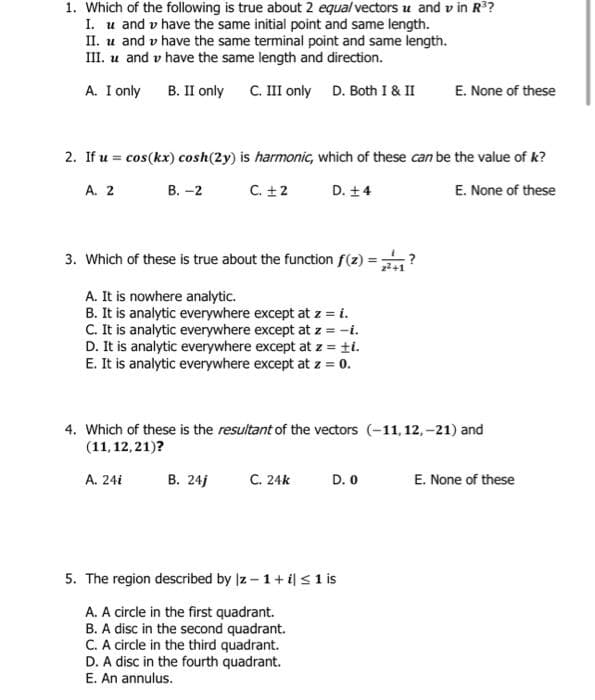1. Which of the following is true about 2 equal vectors u and v in R? I. u and v have the same initial point and same length. II. u and v have the same terminal point and same length. III. u and v have the same length and direction. A. I only B. II only C. III only D. Both I & II E. None of these
1. Which of the following is true about 2 equal vectors u and v in R? I. u and v have the same initial point and same length. II. u and v have the same terminal point and same length. III. u and v have the same length and direction. A. I only B. II only C. III only D. Both I & II E. None of these
Linear Algebra: A Modern Introduction
4th Edition
ISBN:9781285463247
Author:David Poole
Publisher:David Poole
Chapter1: Vectors
Section1.3: Lines And Planes
Problem 8AEXP
Related questions
Question

Transcribed Image Text:1. Which of the following is true about 2 equal vectors u and v in R?
I. u and v have the same initial point and same length.
II. u and v have the same terminal point and same length.
III. u and v have the same length and direction.
A. I only B. II only C. III only D. Both I & II
E. None of these
2. If u = cos(kx) cosh(2y) is harmonic, which of these can be the value of k?
%3D
В. -2
C. +2
E. None of these
A. 2
D. +4
3. Which of these is true about the function f(z) =?
22+1
A. It is nowhere analytic.
B. It is analytic everywhere except at z = i.
C. It is analytic everywhere except at z = -i.
D. It is analytic everywhere except at z = ti.
E. It is analytic everywhere except at z = 0.
4. Which of these is the resultant of the vectors (-11,12,-21) and
(11,12, 21)?
A. 24i
В. 24)
C. 24k
D. 0
E. None of these
5. The region described by z - 1+ il s 1 is
A. A circle in the first quadrant.
B. A disc in the second quadrant.
C. A circle in the third quadrant.
D. A disc in the fourth quadrant.
E. An annulus.
Expert Solution
This question has been solved!
Explore an expertly crafted, step-by-step solution for a thorough understanding of key concepts.
Step by step
Solved in 2 steps with 2 images

Recommended textbooks for you

Linear Algebra: A Modern Introduction
Algebra
ISBN:
9781285463247
Author:
David Poole
Publisher:
Cengage Learning

Algebra & Trigonometry with Analytic Geometry
Algebra
ISBN:
9781133382119
Author:
Swokowski
Publisher:
Cengage

Elementary Linear Algebra (MindTap Course List)
Algebra
ISBN:
9781305658004
Author:
Ron Larson
Publisher:
Cengage Learning

Linear Algebra: A Modern Introduction
Algebra
ISBN:
9781285463247
Author:
David Poole
Publisher:
Cengage Learning

Algebra & Trigonometry with Analytic Geometry
Algebra
ISBN:
9781133382119
Author:
Swokowski
Publisher:
Cengage

Elementary Linear Algebra (MindTap Course List)
Algebra
ISBN:
9781305658004
Author:
Ron Larson
Publisher:
Cengage Learning

Trigonometry (MindTap Course List)
Trigonometry
ISBN:
9781305652224
Author:
Charles P. McKeague, Mark D. Turner
Publisher:
Cengage Learning